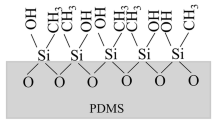Abstract
Polydimethylsiloxane (PDMS) is commonly used in microchip fabrication due to its biocompatibility, which is essential for biological applications, as well as other properties, including transparency to visible light, controllable gas permeability, mechanical and heat stability, and elasticity. Despite these properties, adsorption of biomolecules remains a major limitation of PDMS in biochips. Methods to prevent sample adsorption have been reported, and herein we compare several surface engineering methods that do not incorporate plasma pretreatment. Three methods - Teflon coating, water-repellent spraying, and perfluorodecyltrichlorosilane (FDTS) blending - were compared by evaluating the amount of fluorescein-isothiocyanate- conjugated bovine serum albumin (FITC-BSA) adsorbed onto the biochips. FDTS-blended PDMS significantly inhibited protein adsorption and showed good oleophobicity, but provided the lowest visible light transmittance of all materials tested.
Similar content being viewed by others
References
Anderson, J.R. et al. Fabrication of topologically complex three-dimensional microfluidic systems in PDMS by rapid prototyping. Anal. Chem. 72, 3158–3164 (2000).
Toepke, M.W. & Beebe, D.J. PDMS absorption of small molecules and consequences in microfluidic applications. Lab Chip 6, 1484–1486 (2006).
Fujii, T. PDMS-based microfluidic devices for biomedical applications. Microelectron. Eng. 61-62, 907–914 (2002).
Shin, S. et al. Separation of extracellular nanovesicles and apoptotic bodies from cancer cell culture broth using tunable microfluidic systems. Sci. Rep. 7, 9907 (2017).
Huang, B., Wu, H., Kim, S. & Zare, R.N. Coating of poly(dimethylsiloxane) with n-dodecyl-beta-D-maltoside to minimize nonspecific protein adsorption. Lab Chip 5, 1005–1007 (2005).
Wong, I. & Ho, C.M. Surface molecular property modifications for poly(dimethylsiloxane) (PDMS) based microfluidic devices. Microfluid. Nanofluid. 7, 291–306 (2009).
Nagahashi, K., Teramura, Y. & Takai, M. Stable surface coating of silicone elastomer with phosphorylcholine and organosilane copolymer with cross-linking for repelling proteins. Colloids Surf. B Biointerfac. 134, 384–391 (2015).
Tan, S.H., Nguyen, N.T., Chua, Y.C. & Kang, T.G. Oxygen plasma treatment for reducing hydrophobicity of a sealed polydimethylsiloxane microchannel. Biomicrofluidics 4, 032204 (2010).
Adly, N.Y. et al. Observation of chemically protected polydimethylsiloxane: towards crack-free PDMS. Soft Matter 13, 6297–6303 (2017).
Paik, S-.M., Park, J.W., Kang, M.W., Na, S.C. & Jeon N.L. Teflon-coating in PDMS microfluidic channel that resist hydrophobic molecule absorption. Proceedings of The Korean Society of Mechanical Engineering 2014 Conference 2745–2748 (2014).
Park, J.W., Na, S., Kang, M., Sim, S.J. & Jeon, N.L. PDMS microchannel surface modification with Teflon for algal lipid research. BioChip J. 11, 180 (2017).
Qu, B., Eu, Y.J., Jeong, W.J. & Kim, D.P. Droplet electroporation in microfluidics for efficient cell transformation with or without cell wall removal. Lab Chip 12, 4483–4488 (2012).
Pan, Z., Shahsavan, H., Zhang, W., Yang, F.K. & Zhao, B. Superhydro-oleophobic bio-inspired polydimethylsiloxane micropillared surface via FDTS coating/blending approaches. Appl. Surf. Sci. 324, 612–620 (2015).
Haynes, W.M. CRC Handbook of Chemistry and Physics, Edn. 96. (CRC Press, 2015).
Jeyachandran, Y.L., Mielczarski, E., Rai, B. & Mielczarski, J.A. Quantitative and Qualitative Evaluation of Adsorption/Desorption of Bovine Serum Albumin on Hydrophilic and Hydrophobic Surfaces. Langmuir 25, 11614–11620 (2009).
Zhang, H. et al. Fabrication of Robust Hydrogel Coatings on Polydimethylsiloxane Substrates Using Micropillar Anchor Structures with Chemical Surface Modification. ACS App. Mater. Interfac. 6, 9126–9133 (2014).
Roach, P., Farrar, D. & Perry, C.C. Interpretation of Protein Adsorption: Surface-Induced Conformational Changes. J. Am. Chem. Soc. 127, 8168–8173 (2005).
Stetsyshyn, Y. et al. Synthesis and Postpolymerization Modification of Thermoresponsive Coatings Based on Pentaerythritol Monomethacrylate: Surface Analysis, Wettability, and Protein Adsorption. Langmuir 31, 9675–9683 (2015).
Coelho, M.A.N., Vieira, E.P., Motschmann, H., Möhwald, H. & Thünemann, A.F. Human Serum Albumin on Fluorinated Surfaces. Langmuir 19, 7544–7550 (2003).
Author information
Authors and Affiliations
Corresponding author
Electronic supplementary material
Rights and permissions
About this article
Cite this article
Shin, S., Kim, N. & Hong, J.W. Comparison of Surface Modification Techniques on Polydimethylsiloxane to Prevent Protein Adsorption. BioChip J 12, 123–127 (2018). https://doi.org/10.1007/s13206-017-2210-z
Received:
Accepted:
Published:
Issue Date:
DOI: https://doi.org/10.1007/s13206-017-2210-z




